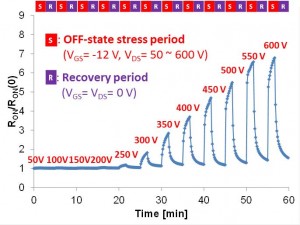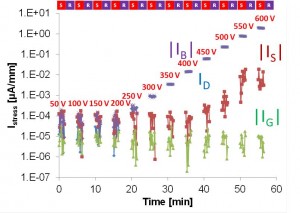Reliability of GaN MIS-HEMTs for Power-switching Applications
- Category: Electronic Devices
- Tags: donghyun jin, jesus del alamo
Engineering energy-efficient power electronic systems has recently attracted tremendous interest. Similarly, the gallium nitride metal-insulator-semiconductor high-electron-mobility transistor (GaN MIS-HEMT) fabricated on large diameter Si substrates has emerged as a commercially viable technology promising both low price and better than three orders of magnitude improvement in the ON-resistance (RON)/breakdown-voltage trade-off over state-of-the-art Si power-switching devices. However, its unknown electrical reliability hampers wide deployment of this technology. A particularly critical concern is the dynamic ON resistance (RON)[1],[2], in which the RON of the transistor substantially increases and remains high for a time after an OFF-ON switching event. This anomaly significantly reduces the total efficiency in a power management circuit system.
Figure 1 shows an example of the evolution of RON in GaN-on-Si MIS-HEMTs designed for high-voltage operation of more than 600 V in an OFF-state step-stress-recovery experiment. Here, a 150-sec OFF-state stress period is followed by a 150-sec recovery period at rest (VDS=VGS=0 V). The sample is in the dark, and RON has been continuously characterized every 10 sec. For each stress period, VGS= -12 V and VDS is increased from 50 V to 600 V in 50 V steps. During the stress periods, RON substantially increases as VDS increases from 250 V to 600 V and in the following recovery periods, it slowly decreases to the initial value. Additional UV light illumination experiments on this sample prove that the increase in dynamic RON is fully recoverable up to 600 V. The observed behavior suggests that heavy electron trapping takes place in the device as a result of the applied high voltage under OFF-state operation. This eventually deteriorates the energy efficiency of the entire power system.
Figure 2 shows all four terminal leakage currents during the stress periods. In these MIS-HEMTs, the dominant breakdown leakage current appears to flow from the drain to the substrate. No degradation in the gate leakage current is observed. This finding suggests that the gate leakage current is less relevant for the RON increase in Figure 1. However, engineering the high resistive buffer and Si substrate to reduce vertical leakage current becomes very important in achieving higher breakdown-voltage as well as suppression of any related trapping effects. For a GaN-on-Si MIS-HEMT high-frequency power switching technology to become commercial, the dynamic RON phenomena should be well understood and ultimately resolved down to times in the sub-µs range.
- Figure 1: Time evolution of RON/RON(0) in the OFF-state step-stress-recovery experiment in GaN MIS-HEMTs. VDS is step-stressed from 50 V to 600 V in 50 V steps and 150-sec stress periods. A 150-sec recovery period follows each stress period. Electron trapping during the high-voltage OFF-state operation induces significant but slowly recoverable RON degradation.
- Figure 2: Time evolution of source (IS), gate (IG), drain (ID), substrate (IB) leakage currents in the stress periods of Figure 1. As the OFF-state bias increases, the drain-to-substrate leakage current also increases with a minor increase in the source current. The gate leakage current is stable, presumably due to the robust MIS structure and field plate engineering.
- D. Jin and J. A. del Alamo, “Mechanisms responsible for dynamic on-resistance in GaN high-voltage HEMTs,” Power Semiconductor Devices and ICs (ISPSD), 2012 24th International Symposium on, pp. 333-336, Jun. 2012. [↩]
- D. Jin and J. A. del Alamo, “Impact of high-power stress on dynamic ON-resistance of high-voltage GaN HEMTs,” Microelectron. Reliab., vol. 52, no. 12, pp. 2875-2879, Dec. 2012. [↩]

